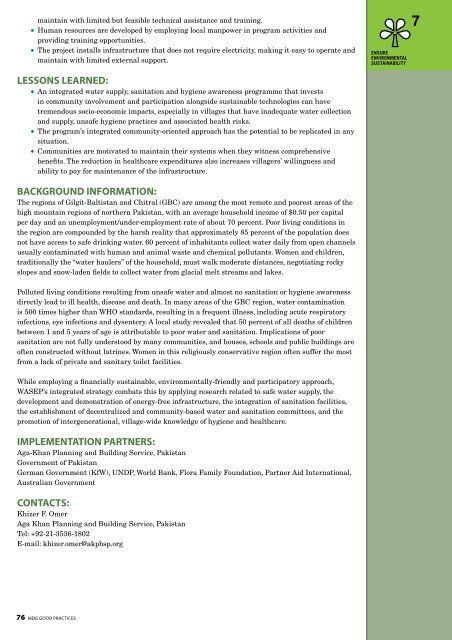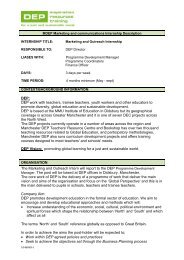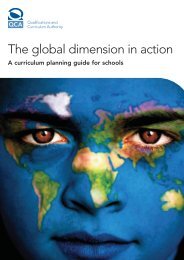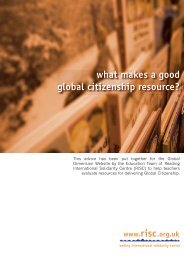Download - United Nations in Cambodia
Download - United Nations in Cambodia
Download - United Nations in Cambodia
- No tags were found...
You also want an ePaper? Increase the reach of your titles
YUMPU automatically turns print PDFs into web optimized ePapers that Google loves.
ma<strong>in</strong>ta<strong>in</strong> with limited but feasible technical assistance and tra<strong>in</strong><strong>in</strong>g.• Human resources are developed by employ<strong>in</strong>g local manpower <strong>in</strong> program activities andprovid<strong>in</strong>g tra<strong>in</strong><strong>in</strong>g opportunities.• The project <strong>in</strong>stalls <strong>in</strong>frastructure that does not require electricity, mak<strong>in</strong>g it easy to operate andma<strong>in</strong>ta<strong>in</strong> with limited external support.Lessons Learned:• An <strong>in</strong>tegrated water supply, sanitation and hygiene awareness programme that <strong>in</strong>vests<strong>in</strong> community <strong>in</strong>volvement and participation alongside susta<strong>in</strong>able technologies can havetremendous socio-economic impacts, especially <strong>in</strong> villages that have <strong>in</strong>adequate water collectionand supply, unsafe hygiene practices and associated health risks.• The program’s <strong>in</strong>tegrated community-oriented approach has the potential to be replicated <strong>in</strong> anysituation.• Communities are motivated to ma<strong>in</strong>ta<strong>in</strong> their systems when they witness comprehensivebenefits. The reduction <strong>in</strong> healthcare expenditures also <strong>in</strong>creases villagers’ will<strong>in</strong>gness andability to pay for ma<strong>in</strong>tenance of the <strong>in</strong>frastructure.Background Information:The regions of Gilgit-Baltistan and Chitral (GBC) are among the most remote and poorest areas of thehigh mounta<strong>in</strong> regions of northern Pakistan, with an average household <strong>in</strong>come of $0.50 per capitalper day and an unemployment/under-employment rate of about 70 percent. Poor liv<strong>in</strong>g conditions <strong>in</strong>the region are compounded by the harsh reality that approximately 85 percent of the population doesnot have access to safe dr<strong>in</strong>k<strong>in</strong>g water. 60 percent of <strong>in</strong>habitants collect water daily from open channelsusually contam<strong>in</strong>ated with human and animal waste and chemical pollutants. Women and children,traditionally the “water haulers” of the household, must walk moderate distances, negotiat<strong>in</strong>g rockyslopes and snow-laden fields to collect water from glacial melt streams and lakes.Polluted liv<strong>in</strong>g conditions result<strong>in</strong>g from unsafe water and almost no sanitation or hygiene awarenessdirectly lead to ill health, disease and death. In many areas of the GBC region, water contam<strong>in</strong>ationis 500 times higher than WHO standards, result<strong>in</strong>g <strong>in</strong> a frequent illness, <strong>in</strong>clud<strong>in</strong>g acute respiratory<strong>in</strong>fections, eye <strong>in</strong>fections and dysentery. A local study revealed that 50 percent of all deaths of childrenbetween 1 and 5 years of age is attributable to poor water and sanitation. Implications of poorsanitation are not fully understood by many communities, and houses, schools and public build<strong>in</strong>gs areoften constructed without latr<strong>in</strong>es. Women <strong>in</strong> this religiously conservative region often suffer the mostfrom a lack of private and sanitary toilet facilities.While employ<strong>in</strong>g a f<strong>in</strong>ancially susta<strong>in</strong>able, environmentally-friendly and participatory approach,WASEP’s <strong>in</strong>tegrated strategy combats this by apply<strong>in</strong>g research related to safe water supply, thedevelopment and demonstration of energy-free <strong>in</strong>frastructure, the <strong>in</strong>tegration of sanitation facilities,the establishment of decentralized and community-based water and sanitation committees, and thepromotion of <strong>in</strong>tergenerational, village-wide knowledge of hygiene and healthcare.Implementation Partners:Aga-Khan Plann<strong>in</strong>g and Build<strong>in</strong>g Service, PakistanGovernment of PakistanGerman Government (KfW), UNDP, World Bank, Flora Family Foundation, Partner Aid International,Australian GovernmentContacts:Khizer F. OmerAga Khan Plann<strong>in</strong>g and Build<strong>in</strong>g Service, PakistanTel: +92-21-3536-1802E-mail: khizer.omer@akpbsp.org76 MDG Good Practices








